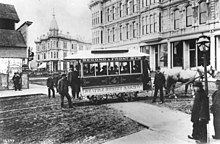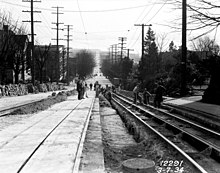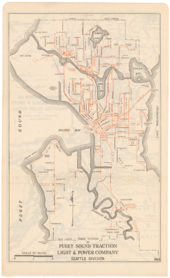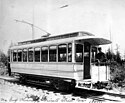| Seattle Municipal Street Railway | |||||||||||
|---|---|---|---|---|---|---|---|---|---|---|---|
 Seattle Street Railway's first streetcar at Occidental Avenue and Yesler Way with Mayor John Leary and city officials in the fall of 1884 Seattle Street Railway's first streetcar at Occidental Avenue and Yesler Way with Mayor John Leary and city officials in the fall of 1884 | |||||||||||
| Operation | |||||||||||
| Locale | Seattle, Washington | ||||||||||
| |||||||||||
| |||||||||||
| |||||||||||
The Seattle Municipal Street Railway was a city-owned streetcar network that served the city of Seattle, Washington and its suburban neighborhoods from 1919 to 1941. It was a successor to the horse-drawn Seattle Street Railway established in 1884, and immediate successor to the Puget Sound Traction, Power and Light Company's Seattle division.
History
Origins and consolidation



The first streetcars in Seattle were operated by Frank Osgood as the Seattle Street Railway, which ran horsecars starting from September 23, 1884. Osgood went on to convert the horsecars to electric traction as the Seattle Electric Railway and Power Company, beginning with a test on March 30, 1889 and followed by regular service the next day. By 1891, Seattle had 78 mi (126 km) of street railway tracks, of which 70 mi (110 km) had been built since 1889.

In 1898, Stone & Webster began assembling a transit system by consolidating several smaller streetcar lines, including the Seattle Electric Railway. By 1900, Stone & Webster had amalgamated 22 lines and gained a 40-year operating franchise under a new power and transport utility named the Seattle Electric Company. The system also included cable car lines on Madison Street and Yesler Way. By the end of 1900, the City Council, under public pressure, forced Seattle Electric to provide free transfers between lines, and reduced their lease to 35-years. In 1907, Stone & Webster also acquired the lease to the Everett streetcar system, and in 1912 it combined all of its transit and utility holdings in the area under a new company, the Puget Sound Traction, Power and Light Company (PSTP&L).
Municipal acquisition
The City of Seattle entered into direct competition with Seattle Electric by furnishing electricity in 1905 after completing the Seattle Municipal Light and Power Plant. As Seattle Electric was distinctly unpopular with the citizens of Seattle and prevented by a state mandate, several requests for fare increases from the existing 5 cents were denied; meanwhile, there was an increasing need to transport tens of thousands of workers responding to the demand for ships resulting from World War I. High shipworker wages and the lack of fare increases meant that by early summer 1918, approximately 1⁄5 of Seattle Electric's cars were idle because they could not pay operators enough. In September 1918, PSTP&L agreed to sell its lines to the city, and several months of increasingly acrimonious negotiations followed.
On March 31, 1919, the city of Seattle purchased the entire Seattle division of PSTP&L's street railways but the price of the acquisition, US$15,000,000 (equivalent to $263,600,000 in 2023), left the transit operation with an immense debt and an immediate need to raise fares, which hurt ridership. By 1936, the city still owed half the principal on the 1918 bonds used to purchase the system, and was faced with a $4 million operating deficit.
In 1939, a new transportation agency, the Seattle Transit System, was formed, which refinanced the remaining debt and began replacing equipment with "trackless trolleys" (as then known) and motor buses. Yesler Way's cable car operation closed out that mode of service with a final run on August 9, 1940. The last streetcar ran on April 13, 1941.
Revival
Main article: Seattle StreetcarA modern streetcar system debuted in 2007, with the introduction of the South Lake Union Streetcar. A second line, the First Hill Streetcar, opened in 2016. Further expansion plans were shelved in 2018 and remained unfunded as of 2024.
Legacy
- In 1973, Seattle Transit was absorbed by the Municipality of Metropolitan Seattle (which later was replaced by King County Metro).
- After selling its streetcar lines, PSTP&L eventually became Puget Sound Energy.
See also
References
- ^ Crowley, Walt (February 10, 2000). "Street Railways in Seattle". historylink.org. Retrieved February 16, 2017.
- Crowley, Walt (October 2, 2000). "Streetcars first enter service in Seattle on September 23, 1884". HistoryLink. Retrieved January 10, 2022.
- Crowley, Walt (October 3, 2000). "Electric trolley line in Seattle begins regular service on March 31, 1889". HistoryLink. Retrieved January 10, 2022.
- ^ Kershner, Jim (2019). Transit: The Story of Public Transportation in the Puget Sound Region. HistoryLink, Documentary Media. pp. 16, 28, 32, 37. ISBN 9781933245553. OCLC 1084619121.
- ^ "Seattle Railway Systems, Part 1". The Street Railway Review. 1 (9): 372–378. September 15, 1891.
- ^ "Seattle Railway Systems, Part 2". The Street Railway Review. 1 (10): 439–444. October 1891.
- Crowley, Walt (1993). Routes : An Interpretive History of Public Transportation in Metropolitan Seattle. Seattle: Crowley Associates. p. 16.
- ^ Douglas, Paul H. (June 1921). "The Seattle Municipal Street-Railway System". The Journal of Political Economy. 29 (6): 455–477. doi:10.1086/253363. S2CID 155001932.
- Holmgren, Don F. (Spring 2007). "The California Street Cable R.R. Co. and the John Hammond Car Co.'s Connection to the Emerald City - Seattle". Bay Area Electric Railway Association Journal (2): 5–8.
- "Cost estimates soar for potential new downtown Seattle streetcar". The Seattle Times. January 19, 2024. Retrieved March 15, 2024.
Further reading
- "Seattle Railway Systems, Part 1". The Street Railway Review. 1 (9): 372–378. September 15, 1891.
- "Seattle Railway Systems, Part 2". The Street Railway Review. 1 (10): 439–444. October 1891.
- Blanchard, Leslie (1969). The Street Railway Era in Seattle: A Chronicle of Six Decades. Harold E. Cox.
- Lane, Bob (1995). Better Than Promised: An informal history of the Municipality of Metropolitan Seattle. Seattle.
{{cite book}}: CS1 maint: location missing publisher (link)
External links
 Media related to Category:History of streetcars in Seattle at Wikimedia Commons
Media related to Category:History of streetcars in Seattle at Wikimedia Commons- "Seattle's Street Railway System and the Urban Form" (PDF). washington.edu.
| Mass transit in the Puget Sound region | |
|---|---|
| Transportation in Seattle | |
| Local and express bus | |
| Light rail |
|
| Streetcar |
|
| Commuter rail | |
| Bus rapid transit | |
| Ferry | |
| Monorail |
|
| People mover | |
| Historic | |
| Other | |
| Italics denote lines or services which are planned, under construction, defunct, or otherwise not operating at the present time. | |








